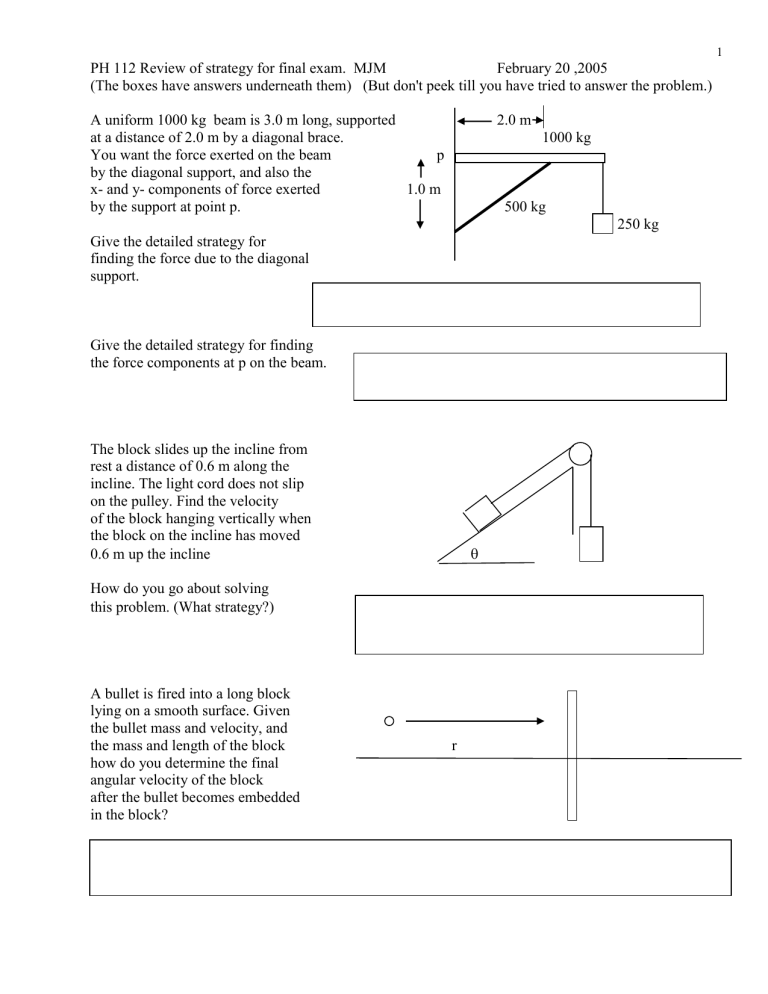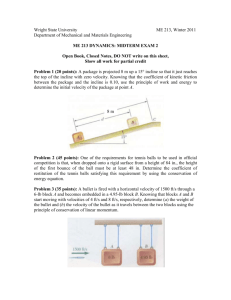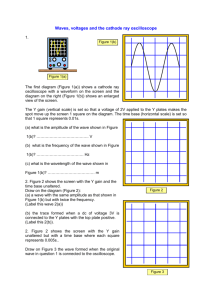PH 112 Review of strategy for final exam. MJM

PH 112 Review of strategy for final exam. MJM February 20 ,2005
(The boxes have answers underneath them) (But don't peek till you have tried to answer the problem.)
1
A uniform 1000 kg beam is 3.0 m long, supported at a distance of 2.0 m by a diagonal brace.
You want the force exerted on the beam by the diagonal support, and also the
p
2.0 m
1000 kg x- and y- components of force exerted by the support at point p.
Give the detailed strategy for finding the force due to the diagonal
1.0 m
500 kg
250 kg support.
Give the detailed strategy for finding
Sum the torques to zero about point p. There are 3 of them.
(The 500 kg mass of the brace is not needed - it's a distractor.) the force components at p on the beam. Sum all x-forces to zero, all four of them. Solve for Fx
Sum all y-forces to zero, all four of them. Solve for Fy.
The block slides up the incline from rest a distance of 0.6 m along the incline. The light cord does not slip on the pulley. Find the velocity of the block hanging vertically when the block on the incline has moved
0.6 m up the incline
How do you go about solving
Use conservation of energy. You will need 1/2 I
2 for the KE of the pulley. The PE of each block is changing so you must account for that. this problem. (What strategy?)
A bullet is fired into a long block lying on a smooth surface. Given the bullet mass and velocity, and the mass and length of the block how do you determine the final r angular velocity of the block after the bullet becomes embedded in the block?
This requires conservation of angular momentum . Energy is not conserved , since it is a collision, and some of the energy (probably a lot of it) is converted into heat. Find the initial L of the bullet wrt the CM of the block, before and after the collision, and I
for the block after, and v_f = r
_f .
You are given a mass on a spring with m and k given. You are told displacement and velocity at t=0.
How do you find the acceleration at t=0? Get
from k and m, then use a = -
2
x, true for SHM.
How do you find the amplitude and phase of the wave? x(t) = A cos (
t +
). Differentiate to get v(t)
Use x(0) and v(0) to solve for A and
.
You have a wave whose displacement is zero at t=0 and which travels to the left (negative x direction).
The amplitude of the wave is A, and it has frequency f and wavelength
. What is your strategy for writing the equation of the wave?
2
A wave can be written as a sine cosine. Since this one is zero at x=0 and t=0, a sine function will work right off the bat (phase constant is zero). The x and t terms must have the same sign for the wave to go to the left. The x term has to be a pure number and it needs a length in the bottom to balance the x in the top. It must change by 2
when x changes by one wavelength. Same reasoning for the t term, needing to change by 2
when the time changes by one period T.
All electric fields in this problem are in the x-direction.
There is an odd-shaped box 4 as shown. The electric field is E
1
over surfaces 1 and 2, and over surface 3 the field is
E
3
Both fields are in the x-direction only. You are given the dimensions of the box.
E
1
2
1
3
E
3
5
How do you determine the amount of net charge inside the box?
Calculate the flux over all 5 surfaces and equate this to Q net
/
o
= 4
k Q net
The flux is zero over surfaces 4 and 5, and is negative over surfaces 1 and 2, positive over surface 3.
How do you find the charges on the two parallel capacitors if you know the battery voltage and the charge on C
1
? q
1
C
1
Plan A: You know the combined parallel caps have the same total charge q the voltage across them from V = q/C.
Plan B. You subtract V caps.
1
= q
1
/C
1
1
, so you find
from the battery voltage to get the voltage across the parallel
State Kirchhoff's loop rule. Does it apply to circuit with capacitors?
3
The sum of voltage rises and drops around a closed circuit (complete loop) = 0. It applied to every closed ciruit (batteries, diodes, inductors, name it.
You are given a circuit with two loops, two or three batteries, 3 or more resistors and asked to find the currents in each of the three branches. How do you proceed?
Write down two loop equations and one node equation
equations you will die by a death that is gory
Penzance.)
. If you try to solve using three loop
(apologies to W. S. Gilbert and the 'Pirates of
What are the key features of setting up an integral for electric field or electric potential?
Add up dE x
and dE y
for electric field or dV for potential. dE x
= (k dq/r
2
) x-component dV = kdq/r. r is the distance from a tiny dq along the charges you must sum up. r must be expressed in terms of the integration variable the integral must have the proper limits, which will run along the charges to be summed






